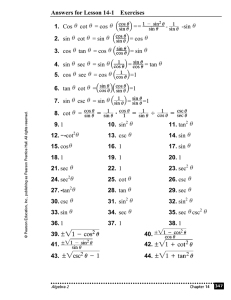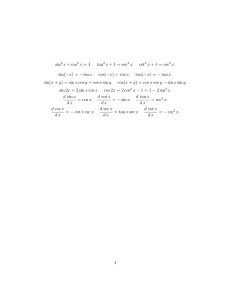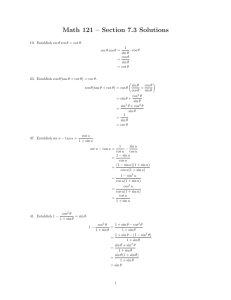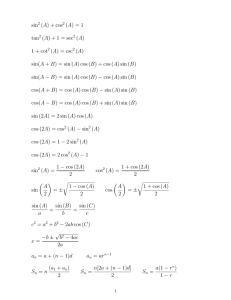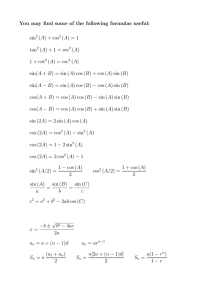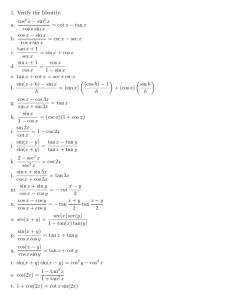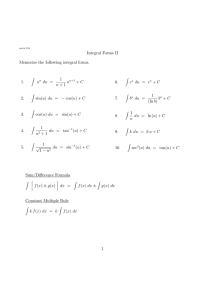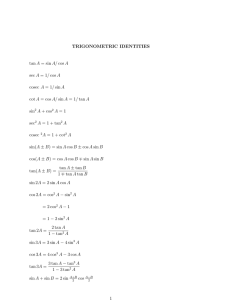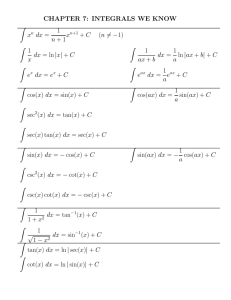VERIFIQUE LAS SIGUIENTES IDENTIDADES 1 a) =
Anuncio
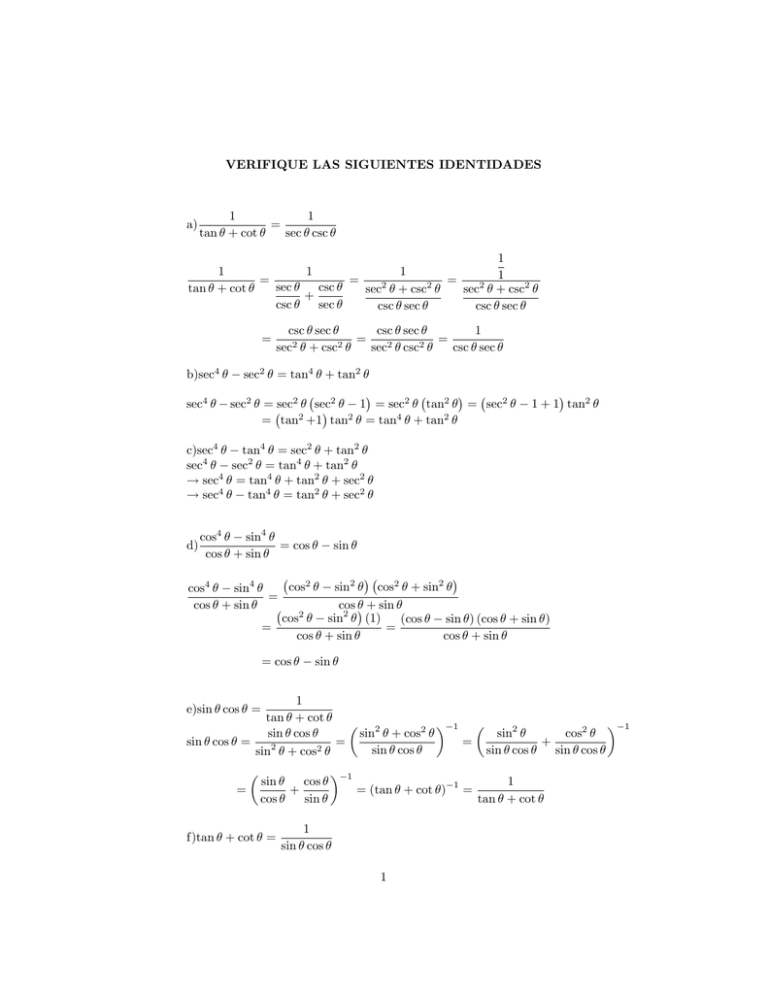
VERIFIQUE LAS SIGUIENTES IDENTIDADES a) 1 tan + cot 1 tan + cot = = 1 sec csc = b)sec4 sec4 1 sec csc + 1 1 = sec2 + csc2 csc sec 1 = 2 sec + csc2 csc sec csc sec csc sec sec2 + csc2 = csc sec sec2 csc2 = 1 csc sec sec2 = tan4 + tan2 sec2 = sec2 sec2 1 = sec2 tan2 2 2 = tan +1 tan = tan4 + tan2 = sec2 1 + 1 tan2 c)sec4 tan4 = sec2 + tan2 4 sec sec2 = tan4 + tan2 4 ! sec = tan4 + tan2 + sec2 ! sec4 tan4 = tan2 + sec2 d) cos4 sin4 cos + sin = cos sin sin2 cos2 + sin2 cos + sin cos2 sin2 (1) (cos sin ) (cos + sin ) = = cos + sin cos + sin cos4 sin4 cos + sin = cos2 = cos sin 1 tan + cot sin cos sin cos = = sin2 + cos2 e)sin cos = = sin cos f)tan + cot = + cos sin sin2 + cos2 sin cos 1 = sin2 sin cos = 1 tan + cot 1 = (tan + cot ) 1 sin cos 1 1 + cos2 sin cos 1 sin cos = 1 tan + cot ! sin cos (tan + cot ) = 1 1 ! tan + cot = sin cos csc cos g) + = 2 cot sec sin cos csc sin + sec cos csc + = sec sin sec sin h) = 1+1 2 = tan tan tan2 + 1 = csc2 tan2 tan2 + 1 sec2 = tan2 tan2 sec2 = 12 sec csc2 = sec2 csc2 sec2 = csc2 cot sec + = sec2 csc cos cot sec cot2 + cos sec cot2 + 1 cot + = = cos cot cos cot sin 1 2 = cot + 1 = csc sec2 sin i) r 1 + cos sin j) = 1 cos s1 cos s r 1 1 + cos (1 + cos ) (1 cos ) = = 1 cos (1 cos ) (1 cos ) (1 s 2 sin sin = 2 = 1 cos (1 cos ) cos2 2 cos ) k)sin6 + cos6 = 1 2 sin2 cos2 3 3 sin6 + cos6 = sin2 + cos6 = 1 cos2 + cos6 2 4 6 = 1 3 cos + 3 cos cos + cos6 2 4 = 1 3 cos + 3 cos = 1 3 cos2 1 cos2 = 1 3 cos2 sin2 l)sec6 sec6 tan6 = 1 + 3 sec2 tan2 tan6 = sec6 1 sin6 = sec6 = sec6 cos2 1 + sin2 + 1 2 1 sin2 cos2 1 + sin2 + sin4 2 = sec4 = sec4 = sec4 = sec4 = 3 sec4 1 + sin2 + 1 2 cos2 + cos4 2 2 cos2 + sin2 + cos4 2 1 cos2 + sin2 + cos4 2 sin2 + sin2 + cos4 = sec4 3 sin2 + cos4 sin2 + sec4 cos4 = 3 tan2 sec2 + 1 Veri…que las siguientes identidades 3 sin + 8 csc 3 i. = + 2 csc2 4 sin 4 8 csc 3 2 csc 3 2 3 sin + = + = + 4 sin 4 sin 4 sin 4 sin2 7 sec4 7 tan4 =7 sec2 + tan2 4 4 7 sec 7 tan sec4 tan4 = 7 sec2 + tan2 sec2 + tan2 = 3 + 2 csc2 4 ii. = 7 sec2 =7 tan2 sec2 + tan2 sec2 sec2 + tan2 =7 1 sin2 cos2 csc3 + sin3 = cot2 + sin2 csc + sin csc3 + sin3 = csc2 csc sin +sin2 = csc2 csc + sin tan2 =7 iii. 1+sin2 = cot2 +sin2 cot3 tan3 = sec2 + csc2 1 cot tan cot3 tan3 = cot2 + tan cot + tan2 = cot2 + 1 + tan2 cot tan = cot2 + sec2 iv. v. cos A + cos B = cos A cos B sec A + sec B cos A + cos B cos A + cos B cos A + cos B = = 1 1 cos B + cos A sec A + sec B + cos A cos B cos A cos B = cos A cos B (cos A + cos B) = cos A cos B cos A + cos B 3 1 = tan sec csc sin 1 sin sin = = csc sin cos2 1 sin2 vi, vii,cos2 cos2 1 + cot2 1 + tan2 = cos2 viisin2 sin2 = sec tan =1 = cos2 1 cos2 1 + cot2 1 + cot2 1 sin cos cos = cos2 = + sin2 cos2 cos2 cos2 =1 =1 cos2 sin2 = sin2 1+ = sin2 1 sin2 = sin2 = sin2 sin2 sin2 + cos2 sin2 =1 sin 1 + cos + = 2 csc 1 + cos sin 2 sin 1 + cos sin2 + (1 + cos ) sin2 + 1 + 2 cos + cos + = = 1 + cos sin (1 + cos ) sin (1 + cos ) sin 1 + 1 + 2 cos 2 (1 + cos ) = = (1 + cos ) sin (1 + cos ) sin 2 = = 2 csc sin ix. x. sin2 + cos2 = 1 sin2 + cos2 = p tan 2 + 1 + tan2 tan2 1 = + 1 + tan2 1 + tan2 p 1 1 + tan2 1 + tan2 = 1 + tan2 MAXIMOS y Minimos f (x) = x2 9 f 0 (x) = 2x ! 2x = 0 ! x = 0 f 00 (x) = 2 > 0 ! x = 0 minimo f (0) = 0 9 = 9 4 2 =1 2 f (x) = 16 x2 f 0 (x) = 2x ! x = 0 punto critico f 00 (x) = 2 < 0 ! x = 0 Maximo f (0) = 16 f (x) = x2 + 2x + 1 f 0 (x) = 2x + 2 ! 2x + 2 = 0 ! 2x = f 00 (x) = 2 > 0 ! x = 1 minimo 2 f ( 1) = ( 1) + 2 ( 1) + 1 = 0 2!x= 1 f (x) = 2x + 3 f 0 (x) = 2 no tine puntos criticos, siempre es creciente no tiene maximos ni minimos f (x) = 3 4x + x2 f 0 (x) = 4 + 2x ! 4 + 2x = 0 ! x = 2 f 00 (x) = 2 > 0 ! x = 2 Minimo f (x) = x 1=2 f 0 (x) = 1 ! f uncion creciente no tiene maximo ni minimo f (x) = x3 + 3x2 25x 75 p 36 + 300 2p = 1 21 f (x) = 3x + 6x 25 = 0 ! x = 6 3 2p x= 21 1 3 00 f (x) = 6x + 6 ! 6x + 6 = 0 ! x = 1 punto in‡eccion x<1 f(x) concaba hacia abajo x>1 f(x) concava hacia arriba 2p ! 1+ 21 minimo 3 p 2 ! 1 21 maximo 3 p 2 f( 1 + 21) = 3 3 2 2p 2p 2p = 1+ 21 + 3 1+ 21 25 1+ 21 75 3 3 3 =-45,02760865 0 2 6 5 2p 21) 3 3 2 2p 2p = 1 21 + 3 1 21 25 3 3 =69,02760865 3 2 f ( 1) = ( 1) + 3 ( 1) 25 ( 1) 75 = 12 f( 1 1 2p 21 3 f (x) = 64x 256 x3 + 4x2 2 2 f 0 (x) = 64 p 3x + 8x ! 3x + 8x + 64 = 0 p 8 64 + 768 4 ! = 1 + 13 6 3 p p 8 + 832 4 ! = 1 13 6 3 f 00 (x) = 6x + 8 ! 6x + 8 = 0 ! x = 4=3 punto in‡exion para x<4/3 la funcion es concava hacia arriba para x>4/3 es concava hacia abajo p 4 1 + 13 punto maximo 3 p 4 1 13 punto minimo 3 f (x) = x2 f 0 (x) = 2x ! x = 0 f 00 (x) = 2 > 0 ! x = 0 Minimo f (0) = (0)2 = 0 f (x) = x f 0 (x) = 1 no tiene maximo ni minimo la funcion es creciente f (x) = x2 f 0 (x) = 2x ! 2x = 0 ! x = 0 f 00 (x) = 2 < 0 ! x = 0 Maximo f (0) = (0)2 = 0 f (x) = x f 0 (x) = 1 no tiene maximo ni minimo la funcion es decreciente f (x) = x2 16 6 75 f 0 (x) = 2x ! 2x = 0 ! x = 0 f 00 (x) = 2 > 0 !la funcion es concava hacia arriba ! x = 0 es minimo f (x) = 3x + 1 f 0 (x) = 3 no tiene maximo ni minimo la funcion es decreciente f (x) = x3 + x2 9x 9 f 0 (x) = 3x2 + 2x ! x (3x + 2) = 0 x = 0; x = 2=3 0 f 0 (x) = 6x + 2 ! 6x + 2 = 0 ! x = 1=3 punto in‡exion para x>-1/3 f(x) es concava hacia arriba para x<-1/3 f(x) es concava hacia abajo Hallese y = cos 1 y0 = 2x 1 x2 p x2 ! cos y = x2 ! dy dx dy 2x dy sin y = 2x ! = dx dx sin y y = cos 1 (1=x) ! cos y = (1=x) dy 1 dy 1 ! sin y = ! = 2 2 dx x dx x sin y y = sec 1 5x ! sin y = 5x dy 5 dy cos y = 5 ! = ! dx dx cos y y = sec 1 (5x) ! sec y = 5x dy dy 5 ! tan y sec y = 5 ! = dx dx tan y sec y p p y = tan 1 x ! tan y = x dy 1 dy 1 p ! csc2 y = p ! = 2 dx dx 2 x 2 csc y x y = cot 1 (1 x) ! cot y = (1 x) dy dy 1 ( csc y) = x ! = = sin2 y dx dx csc2 y y = cos 1 (2x) ! cos y = 2x 7 ! dy 2 = = dx sin y y = 5 tan ! 1 sec2 5 1 2 csc y 3x ! tan 1 y 5 1 y 5 = 3x dy dy =3! = dx dx y = sen 1 (1 x) ! seny = 1 dy dy x cos y = x! = dx dx cos y 15 1 sec2 y 5 = 15 cos2 1 y 5 x y = csc 1 x2 + 1 ! csc y = x2 + 1 dy sin2 y cos y dy = 2x ! = 2x = dx cos y sin2 y dx 2x sin y tan y x x y = sin 1 ! sin y = 2 2 dy 1 dy 1 cos y = ! = sec y dx 2 dx 2 1 x x tan 1 ! tan (3y) = 3 3 3 dy 1 dy 1 3 2 = ! = cos (3y) cos2 (3y) dx 3 dx 9 y= p p y = csc 1 x ! csc y = x cos y dy dy 1 = p ! = 2 dx dx 2 x sin y sin2 y p = 2 x cos y p x sin y tan y 2x p p y = cot 1 x 1 ! cot y = x 1 p 1 dy 1 dy sin2 y x 1 sin2 y p p = ! = = 2 dx dx 2 (x 1) 2 x 1 2 x 1 sin y p csc y + sec y = 2 x dy dy 1 1 ( csc y cot y + sec y tan y) =p ! =p dx dx x x (sec y tan y x 1 x 1 1 y = sin ! sin y = x+1 x+1 dy x+1 x+1 2 cos y = = 2 2 dx (x + 1) (x + 1) dy 2 sec y ! = 2 dx (x + 1) y = csc 1 p x + sec 1 p x 8 csc y cot y) Calcular los siguientes limites 2 (x + h) x2 ((x + h) x) ((x + h) + x) = lim h!0 h!0 h h (h) (2x + h) = lim = lim (2x + h) = 2x h!0 h!0 h h i 2 2 3 ((x + h) x) (x + h) + (x + h) x + x 3 (x + h) x lim = lim h!0 h!0 h h i h 2 2 (h) (x + h) + (x + h) x + x 2 = lim (x + h) + (x + h) x + x2 = lim h!0 h!0 h 2 = (x) + (x) x + x2 = 3x2 lim 3 2 4 ((x + h) x) (x + h) + (x + h) x + (x + h) x2 + x3 (x + h) x4 = lim lim h!0 h!0 h h 3 2 (h) (x + h) + (x + h) x + (x + h) x2 + x3 = lim h!0 h 3 2 = lim (x + h) + (x + h) x + (x + h) x2 + x3 = x3 + x2 x + xx2 + x3 = 4x3 h!0 p p p p x x+h+ x p lim = lim p h!0 h!0 h x+h+ x (x + h x) h = lim p p = lim p p h!0 h h!0 x+h+ x h x+h+ x 1 1 1 p = p = lim p p =p h!0 x + h + x+ x 2 x x p x+h h x3 + 3x2 x!5 x lim p x 25x 5 75 x+h = lim (x x!5 5) x2 + 8x + 15 x 5 x3 + 3x2 + 25x 40x 75 25 + 40 + 15 = x3 + x3 + 3x2 25x 75=x 5 = lim x2 + 8x 15 = 52 + 8 5 15 = 80 x!5 lim x3 x!4 (x x2 16x + 16 = lim x!4 x 4 = lim x2 + 3x x!4 4 4 = 16 + 12 4) x2 + 3x x 4 4 = 4 = 24 (x a) x + ax2 + a2 x + a3 x a = lim x!a x x!a a x a = lim x3 + ax2 + a2 x + a3 = a3 + aa2 + a2 a + a3 = 4a3 4 3 lim x!a 9 (x 3) x2 + 3x + 9 x3 27 = lim x!3 x!3 x 3 x a = lim x2 + 3x + 9 = 9 + 9 + 9 = 27 lim x!3 (x + 2) x2 2x + 4 x3 + 8 lim = lim x! 2 x + 2 x! 2 x+2 = lim x2 2x + 4 = 4 + 4 + 4 = 12 x! 2 x3 + 2x2 x2 (x + 2) x+2 2 lim 4 = lim = lim 2 = = 3 2 2 2 x!0 x + x x!0 x (x + x 6x 6) x!0 x + x 6 6 1 3 Derivadas f ( ) = tan3 (2 ) ! f 0 ( ) = 3 tan2 (2 ) sec2 (2 ) (2) = 6 tan2 (2 ) sec2 2 f ( ) = sec6 (3 ) ! f 0 ( ) = 6 sec5 (3 ) sec (3 ) tan (3 ) 3 f 0 ( ) = 18 sec6 (3 ) tan (3 ) f ( ) = sin5 (2 ) ! f 0 ( ) = 5 sin4 (2 ) cos (2 ) 2 = 10 sin4 (2 ) cos (2 ) f( ) = p 3 cos4 (3 ) ! f 0 ( ) = f( ) = p 5 3 csc2 (3 ) cot(3 ) ! f 0 ( ) = p 5 cot2 (3 ) 4 cos1=3 (3 ) ( sin (3 )) 3 3 p = 4 cos1=3 (3 ) sin (3 ) = 4 sin (3 ) 3 cos (3 ) p 2 f ( ) = 3 csc2 (2 ) ! f 0 ( ) = csc 1=3 (2 ) ( csc (2 ) cot(2 ) 2 3 p 4 4 2=3 = csc (2 ) cot(2 ) = cot(2 ) 3 csc2 (2 ) 3 3 p 3 f ( ) = e tan (2 ) ! f 0( ) = p 3 3p 3 tan (2 ) sec2 (2 )e tan (2 2 2 2 f ( ) = esec (5 ) ! f 0 ( ) = 2 sec(5 ) (sec (5 ) tan (5 )) esec 2 = 2 sec2 (5 ) tan (5 ) esec (5 ) q ) (5 ) 1 2=3 p sin2 (2 ) ! f 0 (x) = q 2 cos(2 ) 3 3 2 sin(2 ) sin (2 ) = 4=3 cot(2 ) f ( ) = ln 3 10 3 f ( ) = ln ecos = (3x) ! f 0 (x) = 9 cos (3x) sin (3x) 1 ecos3 (3x) 11 3 ecos (3x) 3 cos2 (3x) ( 3 sin (3x))
